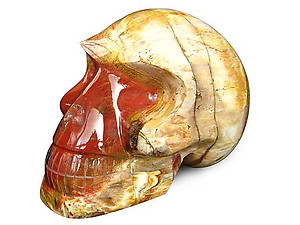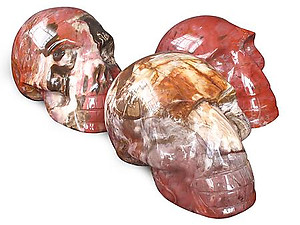Our Products
Petrified Wood is a fossil in which the organic remains have been replaced by minerals in the slow process of turning to stone. This petrification
process generally results in a Quartz Chalcedony mineralization. Special
rare conditions must be met in order for the fallen wood to be
transformed into precious Fossil Wood or Petrified Wood.
In general, the fallen trees get buried in an environment free of
oxygen (anaerobic environment), which preserves the original tree
structure and general appearance. The other conditions include a regular
access to mineral rich water flowing through the wood, replacing the
organic tree structure with inorganic stone. The end result is Petrified Wood,
a tree, with its original basic structure in place, replaced by stone.
This process could occur in less than one thousand years. Exotic
minerals allow the rare red and green hues that can be seen in more rare
specimens.
Fossil Petrified Wood is found in many parts of the world, most commonly perceived to be from Arizona, US. Other significant places known for Petrified Wood
include Madagascar, Brazil, and Indonesia. Madagascar produces, by far,
the largest commercial quantity of brown petrified wood sold on the
world market.
Petrified Wood Skulls
Petrified Wood is a fossil in which the organic remains have been replaced by minerals in the slow process of turning to stone. This petrification
process generally results in a Quartz Chalcedony mineralization. Special
rare conditions must be met in order for the fallen wood to be
transformed into precious Fossil Wood or Petrified Wood.
In general, the fallen trees get buried in an environment free of
oxygen (anaerobic environment), which preserves the original tree
structure and general appearance. The other conditions include a regular
access to mineral rich water flowing through the wood, replacing the
organic tree structure with inorganic stone. The end result is Petrified Wood,
a tree, with its original basic structure in place, replaced by stone.
This process could occur in less than one thousand years. Exotic
minerals allow the rare red and green hues that can be seen in more rare
specimens.
Fossil Petrified Wood is found in many parts of the world, most commonly perceived to be from Arizona, US. Other significant places known for Petrified Wood
include Madagascar, Brazil, and Indonesia. Madagascar produces, by far,
the largest commercial quantity of brown petrified wood sold on the
world market.
Petrified Wood is a fossil in which the organic remains have been replaced by minerals in the slow process of turning to stone. This petrification
process generally results in a Quartz Chalcedony mineralization. Special
rare conditions must be met in order for the fallen wood to be
transformed into precious Fossil Wood or Petrified Wood.
In general, the fallen trees get buried in an environment free of
oxygen (anaerobic environment), which preserves the original tree
structure and general appearance. The other conditions include a regular
access to mineral rich water flowing through the wood, replacing the
organic tree structure with inorganic stone. The end result is Petrified Wood,
a tree, with its original basic structure in place, replaced by stone.
This process could occur in less than one thousand years. Exotic
minerals allow the rare red and green hues that can be seen in more rare
specimens.
Fossil Petrified Wood is found in many parts of the world, most commonly perceived to be from Arizona, US. Other significant places known for Petrified Wood
include Madagascar, Brazil, and Indonesia. Madagascar produces, by far,
the largest commercial quantity of brown petrified wood sold on the
world market.

